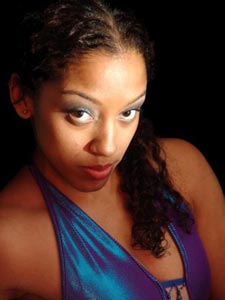Erika Occhipinti
An Interview with Erika Occhipinti -Tampa, FL by Johnny Johnson
 Johnny: First and Foremost, thank you for granting La Voz Del Mambo an opportunity to interview you. We recently met and Spring Salsa Bash in Miami, FL. I must say, it was a pleasure meeting and dancing with you. You are a great dancer! For those who may not know you, can you tell us about your salsa background?
Johnny: First and Foremost, thank you for granting La Voz Del Mambo an opportunity to interview you. We recently met and Spring Salsa Bash in Miami, FL. I must say, it was a pleasure meeting and dancing with you. You are a great dancer! For those who may not know you, can you tell us about your salsa background?
Erika: Thank YOU for the invitation (and the compliment)! I think you’ve done a wonderful job with the newsletter, and I’m thrilled to be a part of it. I really enjoyed meeting and dancing with you as well. I must say I was very impressed with your lead.
So, to answer your question, I’ve been a dancer for pretty much my entire life—I was trained in ballet and jazz since the age of 6—but I’ve been dancing salsa for almost 9 years now and teaching for about 5. I got into it through a girl that I met in my sorority here at the Univ. of South Florida. Her name is Doris (currently teaching in Orlando with Salsa Heat Dance Studio), and she and I became very good friends right away.
One day when we were riding in her car, she started playing a tape of some Latin music and I was hooked instantly! I started listening to the Spanish radio stations, buying CDs, learning to speak Spanish (I signed up for Spanish I the next semester), and going to the Latin clubs with her. Well, actually there was only 1 Latin club at the time. And of course there weren’t any classes. I had to learn the hard way–by watching other people and dancing with different guys.
 A few years later, after I was already a pretty good follower, I took casino-rueda classes. Then in the year 2000, I was offered a job teaching at Salsa Heat Dance Studio in Orlando. It was there that I learned the leader’s part and how to teach.
A few years later, after I was already a pretty good follower, I took casino-rueda classes. Then in the year 2000, I was offered a job teaching at Salsa Heat Dance Studio in Orlando. It was there that I learned the leader’s part and how to teach.
After a few months of going back and forth between Tampa and Orlando, I got tired of the 2-hour commute and decided to start my own classes here in Tampa. I invited some of the advanced dancers from the classes I had taken previously to train to be my instructors, and Salsa Caliente Dance Studio was born! We celebrate our 5-year anniversary on July 30th.
Johnny: You are currently the owner and director of Salsa Caliente Dance Studio (www.tampasalsa.com). What has this experience taught you about the business side of salsa?
Erika: Well honestly, I think I’m a better dancer and teacher than businessperson, but I do my best. The most important thing I’ve learned is that it’s absolutely necessary to have people that you can trust and rely on working with you. It’s just too much for one person, and I couldn’t do it without my awesome staff backing me up, especially my co-director Juan Paredes.
It’s also very important to attend Congresses in order to constantly improve your dancing and to network with other instructors and studio owners. Sometimes you learn so much just by talking to other dancers and teachers. I’ve picked up a lot of ideas and tips that I use in my studio that way.
Johnny: How would you describe the Tampa Salsa Scene?
Erika: Well, we get up to 130 students per night at my studio, so there’s a lot of interest in learning how to dance salsa, but the level of dancing hasn’t really caught up to a lot of other cities yet. Most people dancing in the clubs here have never taken classes, so they don’t know or care about timing. They just dance on any downbeat (1, 3, 5, or 7). The ones who have taken classes mostly dance on 1, and there are a handful of people (less than 20) that have learned to dance on 2.
You’ll see a lot of casino-style dancers here since we have a large Cuban population, but more and more people are dancing a hybrid NY/LA style (which is what we mainly teach at my studio), although you still won’t see many of them incorporating shines.
 Johnny: Is there anyone that has been very inspirational towards you achieving your salsa goals as a dancer, teacher, director and owner?
Johnny: Is there anyone that has been very inspirational towards you achieving your salsa goals as a dancer, teacher, director and owner?
Erika: As a studio owner, I’d have to say Mike Barbieri’s success with Salsa Heat Dance Studio in Orlando has inspired me. He teaches hundreds of students a week at 4 locations! As a teacher, there are a few instructors that have really impressed me. Troy and Georgette are so charming, and they not only break down the steps very clearly so that beginners can understand, but they also make sure even the advanced dancers get something out of their workshops.
Burju Hurturk and Frankie Martínez are both great at using analogies and examples to illustrate whatever movement they’re teaching. Ismael Otero is just hilarious and makes sure everyone has a great time in his classes.
Johnny: Who are some of your favorite dancers and groups in the mambo scene?
Erika: Wow, I have so many. Some of my favorite leaders that I enjoy dancing with (in no particular order) are Troy Anthony (phenomenal lead), Ismael Otero (so creative), Mario B (fast and furious), Eric Baez (great style), Oliver Pineda from Australia (amazing body movement), Junior Alabi (crazy pretzel turns) and Juan Calderón (awesome at leading 2 women at the same time).
As for the ladies, I love to watch April Genovese, Burju Hurturk, Griselle Ponce, Georgette Alcocer, Diana Nuñez, Ana Massicot, Magna Gopal, Lori Ana Perez, and Emily Alabi, among others. My favorite performers to watch include Hacha y Machete, Santo Rico, Yamulée, Caribbean Soul, and Jayson Molina. I’m sure there are some that I’ve forgotten to mention, but those are the ones that come to mind immediately.
Johnny: What do you think are the most important qualities of a great instructor?
Erika: To be an excellent instructor requires a lot more than just being a good dancer. Sometimes the best dancers are terrible instructors, and the best instructors aren’t always the most impressive dancers on the floor.
Since the salsa world doesn’t have a standardized curriculum or certification program like other styles of dance, pretty much anyone can call themselves an instructor, which is unfortunate. I’m not saying we should have that standardization, because I think the very thing that attracts so many people to salsa is its “street” style and lack of strict rules, but it does make it difficult for beginners to know if their instructor is any good. So here are the qualities I think are necessary in order to be a great instructor, regardless of what style is being taught:
- Intimate knowledge of BOTH parts – I think anyone who calls him/herself an instructor should be able to teach both the lead and the follow, plus styling for the men and the women.
- Excellent communication skills – Every instructor should be able to explain what they’re teaching in clear, simple terms that anyone can understand. More specifically, they need to be able to explain the concepts of connection and timing rather than just teaching steps.
- Diagnostic skills – By watching or dancing with a student, they can “diagnose” the problem and tell the student how to go about fixing it.
- Confidence and charm – In addition to teaching the steps effectively, it’s important to make sure the students are having fun, because many of them aren’t necessarily taking classes to become serious dancers or performers. They also come to class to have a good time.
- Ability to control a large group – When students are paying you to take a class, you don’t want to waste their time, so it’s important to keep everyone on task and keep the class moving along.
- Patience – Some students will take longer than others to get it, and as an instructor, it’s important not to appear frustrated.
Johnny: If you were not directing a salsa dance company and running a salsa dance studio, what would you be doing instead?
Erika: I think about that often, actually, and the answer is that I have no idea. I was an excellent student and I have a degree in business administration, so I could have gotten a “real job” if I wanted, but honestly, I think I’d shoot myself if I had to work behind a desk from 9 to 5 every day.
My true love has always been the performing arts, especially singing and dancing. Up until a couple years ago, I wanted to pursue a career as a singer, but it was impossible to do that and run my studio at the same time, and I eventually decided that that’s not really the life I want anyway.
I’m just so thankful to be able to make a living doing something I love. On second thought, I spend a lot of time on the computer, and I actually designed the database that I use for the studio, so maybe I would be doing something along those lines if I wasn’t teaching.
 Johnny: Where would you like to see Tampa Salsa 5 years from now?
Johnny: Where would you like to see Tampa Salsa 5 years from now?
Erika: With a lot more on 2 dancers! Most of the people in the clubs here have only ever seen Tampa dancers. They have no idea how people in other cities dance. They don’t know anything about timing or even that there are different styles of salsa dancing. I want to broaden their horizons and expose them to other styles, and I want to raise the level of dancing here. In other words, I’d like to see improved technique and timing, and dancers that actually USE THE MUSIC instead of just doing pattern after pattern.
It would also be nice if people here would learn to dance on a slot instead of having these huge guys that like to knock out everyone within a 4-foot radius of them. In my classes, I try to expose my students to the older salsa/mambo music instead of the stuff they hear on the radio all the time, and I would love to see nightclubs that cater more to the dancers—wood floors, lots of salsa (especially the older stuff), well-lit, etc. The Tampa scene has definitely come a long way since I started 9 years ago, but it still has a ways to go.
Johnny: Any additional Comments:
Erika: Thank you again Johnny for inviting me to do this interview. I’m truly honored to be asked. For those of you that I haven’t met or danced with, come up and introduce yourself at the next Congress!
Erika Occhipinti
www.tampasalsa.com


Leave a comment